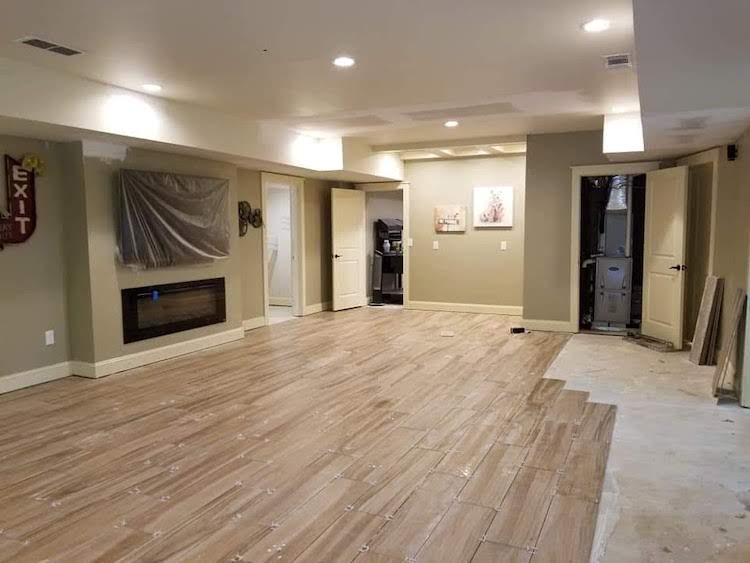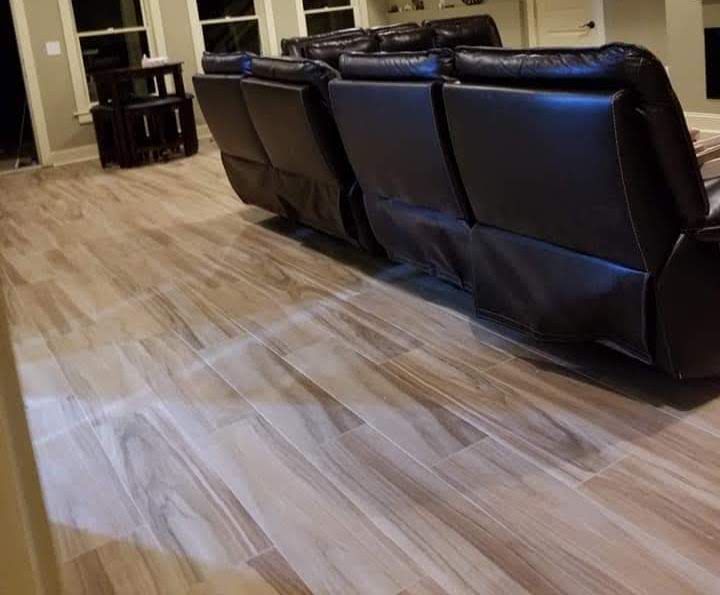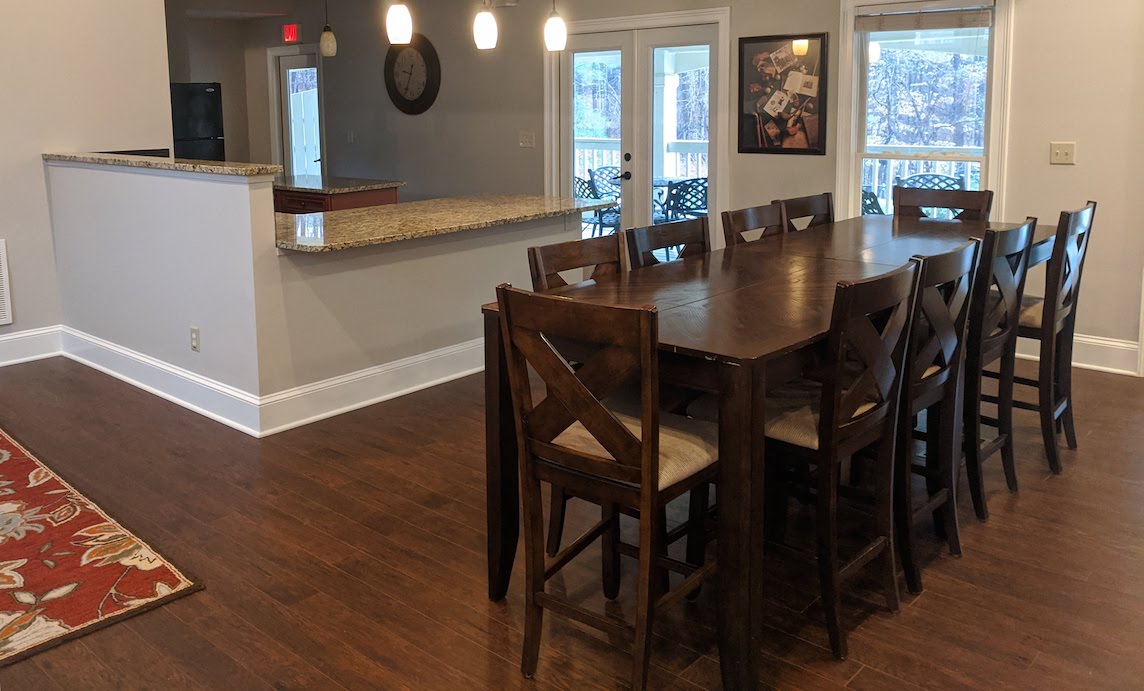Luxury Vinyl Plank (LVP) Flooring: Smart and Stylish Choices
Today, we’re diving into the world of Luxury Vinyl Plank (LVP) flooring – a choice that’s not just smart, but stylish too. If you’ve been wanting to replace your flooring and were thinking about vinyl flooring, most homeowners’ #1 question for us is: “What is the best LVP flooring?” so we wanted to answer that here.
Imagine walking into a room and feeling the solid, yet comfortable touch under your feet. That’s the magic of top-quality LVP flooring. It’s not just about having a pretty floor; it’s about choosing a floor that lasts, feels great, and looks even better.
Why Choosing the Right LVP Flooring is Crucial
- Durability: You need a floor that can handle everything from kids running around to the family pet taking a nap.
- Style: LVP flooring comes in many designs, offering both functionality and aesthetics.
- Quality: Not all LVP flooring is created equal. The best kind has a strong core, often made from stone composite (SPC).
Whether you’re renovating your kitchen, sprucing up the living room, or giving the bathroom a makeover, choosing the right LVP flooring is a big decision.
Stay tuned as we dive deeper into the world of vinyl plank flooring, where durability meets design, and practicality pairs with elegance. We’ll cover everything you need to know – from the must-have features of top-notch LVP to the insider tips on installation and maintenance.
Ready to transform your space with flooring that’s built to last and designed to impress? Let’s get started on this journey to find the perfect LVP flooring for your home!
LVP vs. Traditional Hardwood Floors
How does LVP stand up against traditional hardwood floors?
Hardwood floors are beautiful, no doubt about it. But they come with their own set of challenges. They can scratch easily, they don’t love water, and they can be pretty pricey.
LVP, on the other hand, brings you the beauty of wood without the headaches. It’s tough against wear and tear, doesn’t mind getting a bit wet, and is kinder to your wallet. Plus, with LVP, you get a variety of styles and colors that can match any room or mood.
In short, LVP flooring is like the cool, modern cousin of traditional hardwood. It brings together the best of both worlds – the classic beauty of wood and the modern perks of vinyl. It’s a floor that’s ready for anything – from high heels to high chairs, and everything in between.
Advantages of LVP Flooring
When it comes to choosing the right flooring for your home, LVP flooring stands out for its many advantages. Let’s dive into why it’s becoming the go-to choice for homeowners.
- Waterproof Nature
One of the biggest wins for LVP flooring is its waterproof quality. This makes it perfect for areas like kitchens and bathrooms, where spills and splashes are part of daily life. With LVP, you won’t have to worry every time someone forgets to dry off after a shower or if a drink gets knocked over during family game night.
Keeping up with the latest trends can give your home a modern edge. Discover the top kitchen flooring trends of 2023, including some surprising options that might inspire your next renovation. See the full list of trending kitchen floors.
- Cost-Effectiveness
Dreaming of a hardwood floor look but not thrilled about the price tag? LVP flooring is your budget-friendly hero. It gives you that elegant, high-end look without draining your bank account. This means you can have floors that look luxurious and still have money left for other home improvements or family fun. Check out our blog on some more low cost remodeling ideas
While exploring affordable flooring options, you might also be interested in other low-cost remodeling ideas that can transform your home affordably, enhancing its appeal without breaking the bank. Read our tips on affordable home transformations.
- Ease of Installation
If you’re a fan of DIY projects, you’ll love LVP flooring. Many LVP options come with a user-friendly click-lock design, making installation a breeze. You can literally snap the planks together. It’s like putting together a puzzle, but way more fun because you’re transforming your home! And if DIY isn’t your thing, professional installation is quick and hassle-free, causing minimal disruption to your daily life.

- Variety in Design and Style
LVP flooring is like a chameleon; it can fit into any style you can imagine. Whether you’re into the classic oak look, a trendy gray tone, or something totally unique, LVP has got you covered. The variety of colors and patterns available means you can match your floors to your personal style or room theme without any compromise. It’s like having a custom-made floor for every room in your house!
- Durability and Low Maintenance
With kids, pets, and everyday hustle and bustle, your floors need to be tough. LVP flooring is built to withstand heavy foot traffic, scratches from pet nails, and all the little
- Variety in Design and Style
LVP flooring is like a chameleon; it can fit into any style you can imagine. Whether you’re into the classic oak look, a trendy gray tone, or something totally unique, LVP has got you covered. The variety of colors and patterns available means you can match your floors to your personal style or room theme without any compromise. It’s like having a custom-made floor for every room in your house!
- Durability and Low Maintenance
With kids, pets, and everyday hustle and bustle, your floors need to be tough. LVP flooring is built to withstand heavy foot traffic, scratches from pet nails, and all the little accidents that happen in a busy home. Plus, cleaning is a snap – a quick sweep or a light mop, and it’s like new again. No need for special cleaners or treatments.
- Comfort and Sound Insulation
LVP flooring isn’t just about looks and durability; it’s also about comfort. The SPC core we talked about? It doesn’t just make the floor strong; it also makes it more comfortable to walk on. Plus, LVP is quieter underfoot compared to hardwood or tile, reducing the noise of footsteps – a blessing in a house full of active kids and pets. Eco-Friendly Options
For those who are environmentally conscious, many LVP brands offer eco-friendly options. These are made with sustainable materials and processes, helping you make a choice that’s good for your home and the planet. In the next section, we’ll explore the differences between LVP and LVT flooring, helping you make an informed decision for your home renovation.
LVP vs Laminate: Understanding the Difference
When updating your home’s flooring, you might find yourself choosing between Luxury Vinyl Plank (LVP) and laminate. Both are popular, but they have distinct characteristics and advantages. Understanding these differences can help you make the best choice for your home.
Distinction between LVP and Laminate
LVP (Luxury Vinyl Plank): LVP is a synthetic flooring material designed to mimic hardwood. It’s composed of multiple layers, including a wear layer for durability, a decorative layer with a high-definition image of wood, and a core layer, often made of SPC (stone plastic composite) for stability and strength. LVP is known for its water resistance, making it suitable for areas prone to moisture.
Laminate: Laminate flooring, like LVP, is designed to replicate the look of hardwood. However, it’s primarily made from compressed wood particles. The top layer is a photographic image of wood covered with a clear protective layer. While durable and visually appealing, laminate is more susceptible to damage from moisture and water than LVP, making it less ideal for areas like kitchens and bathrooms.
Situational Preferences for Each Type
In Moisture-Prone Areas: LVP is the clear winner in spaces where moisture is a concern, such as bathrooms, kitchens, and basements. Its water-resistant properties mean spills and humidity won’t cause the warping or swelling often seen with laminate.
On a Budget: If cost is a major factor, laminate flooring generally offers a more budget-friendly option compared to LVP. It provides the look of hardwood without the higher price tag of real wood or higher-end LVP.
For Durability and Longevity: LVP tends to be more durable and long-lasting, especially in high-traffic areas or homes with pets and kids. Its wear layer offers protection against scratches and dents, which can be more of a concern with laminate.
For Ease of Installation: Both LVP and laminate offer DIY-friendly installation options, often featuring click-lock designs. However, LVP might have a slight edge due to its flexibility and ability to handle imperfect subfloor conditions. If you’re considering LVP flooring for a concrete subfloor, understanding the nuances of installation is crucial. Learn more about installing floating wood floors over concrete in our detailed guide, especially tailored for Northwest, GA homes. Check out the expert guide here.
Aesthetic Appeal: Both flooring types offer a wide range of design options. Laminate can have a more realistic wood texture due to its composition, but LVP offers more variety in styles and patterns, including options that mimic tile and stone.
The choice between LVP and laminate will depend on your specific needs, preferences, and the conditions of your home. LVP offers superior water resistance and durability, making it ideal for areas with moisture and heavy use. Laminate, on the other hand, can be a cost-effective solution for dry areas where the look of hardwood is desired without the higher expense.
How to Choose the Best LVP Floors

Selecting the right LVP flooring for your home is crucial. It’s not just about picking a style you like; it’s about finding a floor that meets your needs in terms of durability, functionality, and aesthetics. Here are some key factors to consider when choosing the best LVP flooring:
- Key Specifications: Wear Layer and Floor Thickness
Wear Layer: This is the top coating on the vinyl plank that provides resistance to scratches and stains. A thicker wear layer means better durability, especially important in homes with kids and pets. Look for LVP with at least a 6 MIL wear layer for adequate protection.
Floor Thickness: The overall thickness of the LVP is also important. A thicker floor typically 5 mm or more – offers better sound insulation and a more solid feel underfoot. It can also help to smooth out minor imperfections in the subfloor.
- Reading and Understanding Warranties
Warranties can give you a good idea of the expected lifespan and durability of the LVP. Look for products with longer warranty periods, as this often indicates a higher quality. Pay attention to what the warranty covers – some may cover wear and tear, while others might include protection against fading or water damage.
- Installation Considerations
Consider the installation process and whether the LVP you choose is suitable for your space and DIY abilities. Most LVP comes with a click-lock system that makes installation straightforward, but some types might require additional tools or adhesives. Also, think about the subfloor – LVP with an SPC core can be more forgiving on uneven surfaces.
- Evaluating the Core Material
The core material plays a crucial role in the stability and durability of LVP. An SPC (Stone Plastic Composite) core is known for its rigidity and strength, providing a solid feel and a stable base. This type of core is particularly beneficial in areas with heavy foot traffic or where furniture will be moved frequently, as it helps to prevent the planks from shifting or separating.
Considering the Room’s Functionality
Think about the specific needs of each room where you plan to install LVP. For high-moisture areas like bathrooms and kitchens, water resistance is key. In living spaces and bedrooms, you might prioritize comfort and the floor’s feel underfoot.
Style and Aesthetic Preferences
While functionality is important, the look of your LVP flooring is also crucial. Choose a style that complements your home’s decor and reflects your personal taste. With a wide range of colors, patterns, and textures available, LVP offers the flexibility to match any interior design theme.
Environmental and Health Considerations
If indoor air quality and environmental impact are concerns for you, look for LVP flooring that is certified for low VOC emissions. Some LVP products are also made from recycled materials, offering a more eco-friendly flooring option.
By considering these factors, you can choose LVP flooring that not only looks great but also meets the practical needs of your home.
Caring for Your LVP Flooring
Once you’ve chosen and installed your perfect LVP flooring, maintaining its beauty and longevity is key. Luckily, LVP is low-maintenance, but there are still some best practices to keep it looking its best. Here’s how to care for your LVP flooring effectively:
Daily Maintenance Tips
- Regular Cleaning: Keep your LVP flooring clean by sweeping, dry mopping, or using a vacuum designed for hard surfaces. This regular upkeep helps to remove dirt and grit that can scratch the surface over time. Immediate Spill Cleanup: Although LVP is water-resistant, it’s still a good idea to clean up spills as soon as they happen to prevent any chance of slipping or staining.
Recommended Cleaning Products
- Gentle Cleaners: Use mild, pH-neutral cleaners specifically designed for vinyl flooring. Harsh chemicals can damage the wear layer and dull the appearance of your LVP.
- Avoid Steam Mops: Steam can potentially damage the adhesive or seep through the seams, so it’s best to avoid using steam mops on LVP flooring. Manufacturer’s Recommendations: Always check the cleaning recommendations provided by your LVP manufacturer, as some may suggest specific products or methods.
Precautions to Avoid Damage
- Furniture Pads: Place felt pads under furniture legs to prevent scratches when moving items around.
- Avoid Sharp Objects: Be cautious with sharp objects like high heels or pet nails, as they can potentially puncture or scratch the surface.
- Sunlight Protection: To prevent fading, use curtains or blinds to limit direct sunlight exposure on your LVP flooring.
- Heavy Appliances: When moving heavy appliances or furniture, use plywood panels or furniture sliders to distribute the weight and prevent indentations.
By following these simple care and maintenance tips, your LVP flooring will continue to look beautiful and last for years to come.
Ready to elevate your home with the perfect LVP flooring? Dependable Painting & Remodeling is here to turn your vision into reality. Whether you’re dreaming of a cozy, wood-like floor for your living room or a durable, stylish surface for your bustling kitchen, we’ve got the expertise and options to suit your every need.
Don’t let the multitude of choices overwhelm you. Our team at Dependable Painting & Remodeling is eager to guide you through every step – from selecting the ideal LVP flooring that matches your lifestyle to ensuring a seamless and professional installation.
Schedule Your Free Consultation Today! Our friendly and knowledgeable team is ready to assist you.

